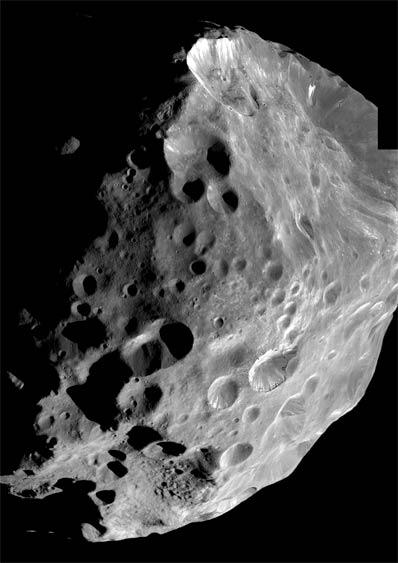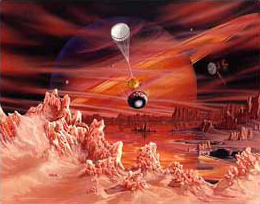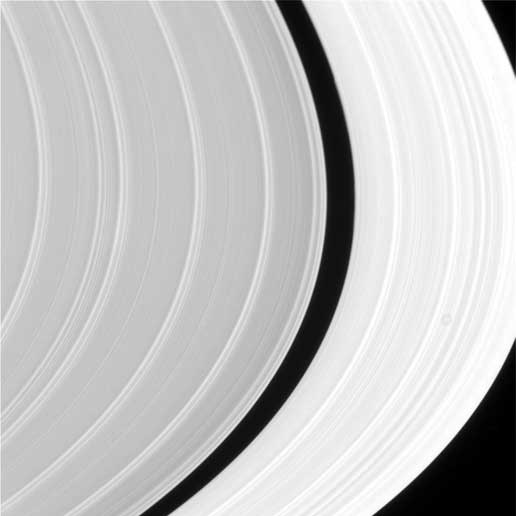Geotimes

Untitled Document

Web Extra
Friday, July 2, 2004
Sliding into Saturn
Late Wednesday night, the Cassini-Huygens spacecraft silently slipped through
the outermost rings of Saturn and entered into orbit. By early Thursday morning,
Cassini began transmitting strikingly elegant close-up images of Saturn's rings.
Achieving orbit around the second largest planet in the solar system and transmitting
images back to Earth is the culmination of a $3.3-billion, seven-year mission
jointly run by NASA, the European Space Agency and the Italian Space Agency.
The Cassini-Huygens spacecraft was launched from Kennedy Space Center in Cape
Canaveral, Fla., on Oct. 15, 1997. The primary research goals are to learn about
the planet Saturn, its famed rings, its largest moon Titan and other satellites.
Although Saturn is not a rocky planet, like Earth or Mars, planetary geologists
have plenty to look at.
Six high-resolution images were combined
to create this mosaic of Phoebe, one of Saturn's moons. Phoebe's surface shows
many craters and an unusual variation in brightness. Researchers used to think
Phoebe was a captured asteroid, but are now rethinking their interpretations.
Image courtesy of NASA/JPL/Space Science Institute.
A few weeks before the spacecraft reached Saturn, it made a close fly-by of
Phoebe, one of Saturn's moons, and already researchers are ogling over the high-resolution
pictures taken from only 1,300 miles away. "Frankly, I expected Phoebe to look
like some of the other asteroids we have seen, but it really surprised me,"
says Rosaly Lopes, a planetary geologist at the Jet Propulsion Laboratory (JPL)
in Pasadena, Calif.
Scientists at JPL now surmise that Phoebe is not an asteroid at all, but a
small planetesimal that formed during the initial development of the solar system
and was captured by Saturn's gravitational field. "Phoebe is a survivor,"
says Alfred McEwen, a planetary scientist at the University of Arizona, Tucson,
and member of the Cassini imaging team. "It is the first good look we have
had of a primitive small body whose birthplace is the outer solar system."
The conglomeration of countless small bodies such as Phoebe led to the formation
of the planets.

Phoebe is only one of Saturn's 31 known moons. Much of the Cassini-Huygens
research will focus on the crown jewel of Saturn's moon system — Titan.
Titan is the second largest moon in the solar system, larger than the planets
Mercury and Pluto, and roughly half the size of Earth. "This is a whole
new planet-sized world," McEwen says. "All bets are off."
This is an artist's interpretation of
what Titan's surface may look like when the Huygens probe descends into the
moon's thick atmosphere. A faint outline of Saturn appears in the background.
Titan's surface may contain lakes of liquid ethane and methane. Image courtesy
of NASA/JPL.
On Christmas Day, the Huygens probe will separate from the Cassini orbiter
and begin its descent into Titan's murky atmosphere. Preliminary images of Titan,
sent back by Cassini on June 14, show the moon shrouded in a haze with dark
and light patches. "They may be continents; there may be oceans of liquid
on the surface," Lopes says. "Titan is still a mystery; it is probably
going to be one of the most interesting objects we learn about."
Once the Huygens probe enters the atmosphere, parachutes will slow its descent
so instruments onboard can start sending data back to Earth. "Titan is
like a snapshot of the early atmospheric chemistry of Earth," McEwen says.
"It gives us insight into what the conditions were when life began."
 If everything
goes well, the probe will eventually touch (or splash) down on Titan's surface,
although scientists are unsure if the probe will survive — it was not designed
for landing. "This is a situation where a whole series of things must happen
for Huygens to make it," McEwen says. To maximize Huygens' chances, scientists
have chosen a large dark spot on Titan, which could be a lake of methane and
ethane, but researchers do not know, he says.
If everything
goes well, the probe will eventually touch (or splash) down on Titan's surface,
although scientists are unsure if the probe will survive — it was not designed
for landing. "This is a situation where a whole series of things must happen
for Huygens to make it," McEwen says. To maximize Huygens' chances, scientists
have chosen a large dark spot on Titan, which could be a lake of methane and
ethane, but researchers do not know, he says.
Early Thursday morning, Cassini sent
back this image of the sunlit side of Saturn's rings. Scientists hope to better
understand the dynamics, composition and formation of the rings. For more images
of Saturn's rings, visit the NASA/JPL official site. Image
courtesy of NASA/JPL/Space Science Institute.
Even if Huygens yields little geologic information about Titan, Cassini will
fly by eight other moons in the next three years. Some of the more interesting
lunar prospects are Iapetus, Mimas and Enceladus. Iapetus is divided into a
reflective, possibly icy side and a dark mysterious side. "It is very peculiar;
the leading side is the dark side and some researchers think it sweeps up dust,"
Lopes explains. Mimas is famous for its similarity to the "Death Star"
in the Star Wars movies; a huge crater covers one-third of its surface.
Enceladus is the most reflective of the moons and may be geologically active,
with giant ice geysers shooting vapor particles into orbit. Some researchers
believe that a faint ring around Saturn, called "ring E," is a result
of these vapor particles, Lopes says, but there are many hypotheses surrounding
the gas giant's rings.
"The whole Saturnian system is dynamic, the interactions between the rings
and satellites are particularly interesting," McEwen says. "Some believe
the rings may be a large satellite that was destroyed — we're going to
be finding out a lot more soon." Scientists believe the rings are mainly
composed of water ice, and the recent images should improve researchers' understanding
of the rings composition. "These are the best images anyone has ever seen,"
Lopes says.
The images are going to keep on coming. The Cassini mission is supposed to
last four years, although the orbiter could be operable for up to 10. Scientists
are particularly excited about the possibility of an extended mission. When
the four-year term is completed, if "NASA declares the mission a success
and lets the scientists make riskier maneuvers," McEwen says,"there
are a lot of things we could do."
Jay Chapman
Geotimes summer intern
Links:
NASA's
Jet Propulsion Laboratory Cassini-Huygens Website
NASA
Cassini-Huygens Website
Editor's note: A
short version of this article appeared
in the August issue of Geotimes.
Back to top
Untitled Document

 If everything
goes well, the probe will eventually touch (or splash) down on Titan's surface,
although scientists are unsure if the probe will survive — it was not designed
for landing. "This is a situation where a whole series of things must happen
for Huygens to make it," McEwen says. To maximize Huygens' chances, scientists
have chosen a large dark spot on Titan, which could be a lake of methane and
ethane, but researchers do not know, he says.
If everything
goes well, the probe will eventually touch (or splash) down on Titan's surface,
although scientists are unsure if the probe will survive — it was not designed
for landing. "This is a situation where a whole series of things must happen
for Huygens to make it," McEwen says. To maximize Huygens' chances, scientists
have chosen a large dark spot on Titan, which could be a lake of methane and
ethane, but researchers do not know, he says.

